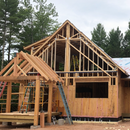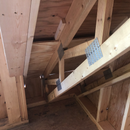Interior Air Barrier and Vent Baffles
I have a story and a half new build with deep parallel chord trusses. My air barrier is Intello and it will be applied to the interior of the truss framing.
Given that the air barrier is to the interior, is it still then necessary to caulk and seal my vent chutes that keep the insulation off the roof deck and allow for roof venting?
I can’t think of why I would need to seal these plywood vent baffles since it is entirely outside of my air barrier.
Thank you!
GBA Detail Library
A collection of one thousand construction details organized by climate and house part











Replies
Michael,
The argument is that they provide a secondary air-barrier - which I also don't think is very persuasive - especially considering the amount of work involved, and that the effect of any wind-washing is negligible.
I don't think it's a big deal to seal those. The way they appear to be built, there is a nailing strip along the edge so you won't just have an open gap the way you would if the baffles were only tacked in place at the edges. If you're really concerned, you could put a bead of sealant on those nail strips before you put the baffles up, but it's probably not really going to gain you anything.
As Malcolm mentioned, the baffle itself is going to block 99+% of any wind-driven airflow, so you don't really have any need to seal the edges to avoid wind washing. With open baffles, I don't seem them being an air barrier, either, especially since you are planning an interior side air barrier anyway.
I would probably just put the baffles up the same way you are, but I'd tape or foam the gaps between baffle sections (assuming the vertical run is more than can be covered with a single piece baffle). I would detail the Intello AND any interior drywall as air barriers, so I'd have my redundant air barriers on the interior (which is better here anyway, in my opionion). Drywall will have fewer seams and gaps, so it will be less effort to detail as an air barrier compared to the many seams and gaps you'll have with a bunch of baffles between rafters.
Bill
In warm weather, an exterior side air barrier reduces moisture entry. In cold weather, once you have a good interior side air barrier, air leaks on the exterior side increase drying.
"air leaks on the exterior side increase drying."
As do vapour-open baffles.
Thank you all. This was really helpful.
I will rely on my Intello to provide my air barrier and not worry too much about detailing the plywood vent baffles.
I was thinking that it wouldn't do much given that it is on open web trusses and it would be nearly impossible to detail those tightly in between the truss bays.
Thanks!